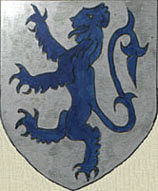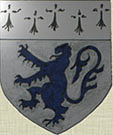
Skelton High Street. From a Postcard dated 1938.
|
12th March - GERMANY INVADED AUSTRIA.
24th August - DEFENCE ACT.
In fear of Hitler's military build up the Defence Act was passed by Parliament enabling protective measures.
|
6th September - GAS MASKS ISSUED.
In response to the fear of poison gas attacks, Gas masks were issued to the public and law passed penalising failure to carry them with you.
By 1940 Air Raid Wardens were checking only that a person possessed one.
15th September - MINE DEATH.

29th September - MUNICH PEACE AGREEMENT.
Hitler and Chamberlain signed the Munich agreement.
21st October. BANKRUPT.
London Gazette.
Steele, Stanley, residing at 144, Oxford Road, Middlesbrough, in the county of York, Dock Foreman, formerly residing and carrying on business
|

Gas masks issued to everyone.
|
at the Duke William Inn, Skelton-in-Cleveland,
in the North Riding of the county of York. Innkeeper. Court Middlesbrough.....
November - AIR RAID PRECAUTIONS - BOMB SHELTERS.
Sir John Anderson was put in charge of Air Raid Precautions.
Between now and the start of the War people could obtain an "Anderson" shelter, a six feet by four, steel plated box.
This was for home construction and used in the garden, covered with earth.
More substantial shelters were built of brick and covered with re-inforced concrete.
Stanghow Lane Secondary Modern School had one in each of the play-yards.
Also a Skelton Green Junior School pupil of the time remembers:-
|
"There were two long shelters at the bottom end of the
school in the Girls' playground.
We used to sit in them and tell stories, as we couldn't have a light on
to read.
It was gloomy and damp with the general smell of the great unwashed.
And of course those poor souls who couldn't get out to the toilet."
We had an Indoor Shelter at 153 High St, Skelton, example shown below.
[not the posh carpet in the photo though, just a clippy mat as a hearth rug, made from old clothes.]
I was just an infant during the War, but I remember splitting my head open on the corner of the metal top, which we used as a "dining" table. Never been the same since.
|
 Indoor Shelter.
Indoor Shelter.
|
 Many warning leaflets were issued in 1938/9.
Many warning leaflets were issued in 1938/9.
|
 Air Raid Precaution Warden with Gas Mask.
Air Raid Precaution Warden with Gas Mask.
|
24th November - EXPLOSION AT NORTH SKELTON IRONSTONE MINE.
An explosion of gas occurred in Number 6 District of this Mine at around 9 a.m.
One miner, John George K Dowson of Trouthall Lane, Skelton Green was killed.
Others suffering burns were Norman Sanderson of Manless Tce, Skelton Green, Frank Cuthbert of North Terrace, Lingdale, Bertram Reed of Wilson St, Lingdale and Robert Spence of Groundhill Cottages, Skelton.
These 4 were all taken to the Miners' Hospital, Skelton Green, where it was reported Cuthbert's condition is very serious.
Thomas Briggs of Allison St, Guisborough was taken to the Guisborough Miners' Hospital where his burns were also described as severe.
It took nearly 3 hours before a rescue party could get to the dead man.
There was still gas in the area which affected attempts at rescue. James Winter, leader of the Mine Ambulance team collapsed on being returned to the pit head.
Special breathing equipment was brought by the Crook and Houghton Le Spring Brigades of the Northumberland and Durham Counties Fire and Rescue services.
The Mine Manager, Mr T E Slater and Skelton Doctor, W. A. Kirkpatrick went down the Mine to assist.
The Mine will be closed down on the 25th until the Deputies have ensured the gas danger has been cleared.
It remained closed until the following March for testing and improvements to ventilation.
12th December - DEATH OF WILLIAM HENRY ANTHONY WHARTON.
Aged 79, at Skelton Castle. Chairman of the Cleveland Water Company and 48 years Master of the Cleveland Hounds.
He was buried in the family plot near the old church.
He left an Estate of £1,169,684, on which £423,470 death duty was paid.
He was succeeded by Margaret Winsome Wharton. She married Captain Christopher Hilyard Ringrose, who changed his name to Ringrose-Wharton in 1939 as a condition of Margaret inheriting the Estate.
|

Margaret Winsome Wharton of Skelton Castle.
|

Thomas E Slater.
Manager of Longacres and North Skelton Mines.
|
Thomas E Slater played a large part in the affairs of this area.
He was a native of Alnwick and did his mine training in the coal mines of Durham, before being appointed a Manager in South Wales and spending some time in Eire.
He was first the Mine Manager of Eston and in December 1933 was appointed at North Skelton.
He retired from North Skelton in December 1952 after nearly 40 years management.
He was a local Magistrate from 1943 and virtually died in that job. Shortly after taking his seat on Loftus Bench he complained of feeling ill and died a few minutes after arriving back at his home, The Anchorage, Port Mulgrave, Hinderwell.
Date of death not presently known.
He was responsible for introducing safety features at N Skelton and formed the Mines Ambulance Association. Under his guidance the Mine had 10 competitive ambulance teams and a fully trained team for every 72 men.
The under-manager at North Skelton was H Garbutt. There were only 82 miners below ground with 9 on the surface.
The managers of North Skelton mine were T E Slater and F Weels.
There were 541 men employed below and 110 on the surface.
|
The manager at South Skelton was J Clement. The under-manager was J Crombie. 498 men worked below ground and 109 on the surface.
CLOSURE OF SKELTON PARK AND SHAFT MINES.
The Manager at the time was J Clement
The under-manager at Skelton Park was M Readman and 172 men were employed below with 69 on the surface.
The under-manager at Shaft was J Forbes and there were only 67 men working underground and 14 on the surface.
|

Skelton Park Pit as it was in 1904.
|
|
Some of the leaflets issued to householders in 1938/9.
|
|



